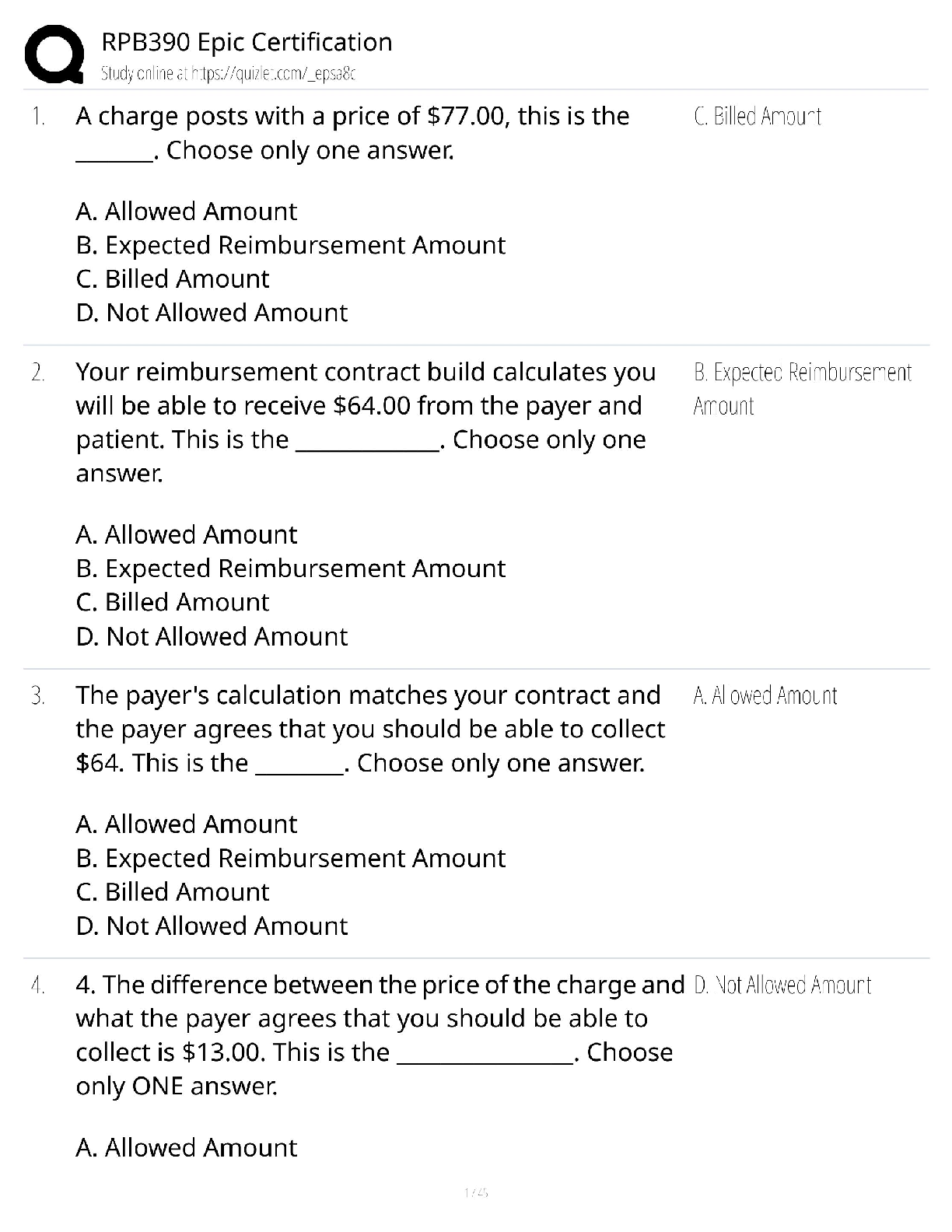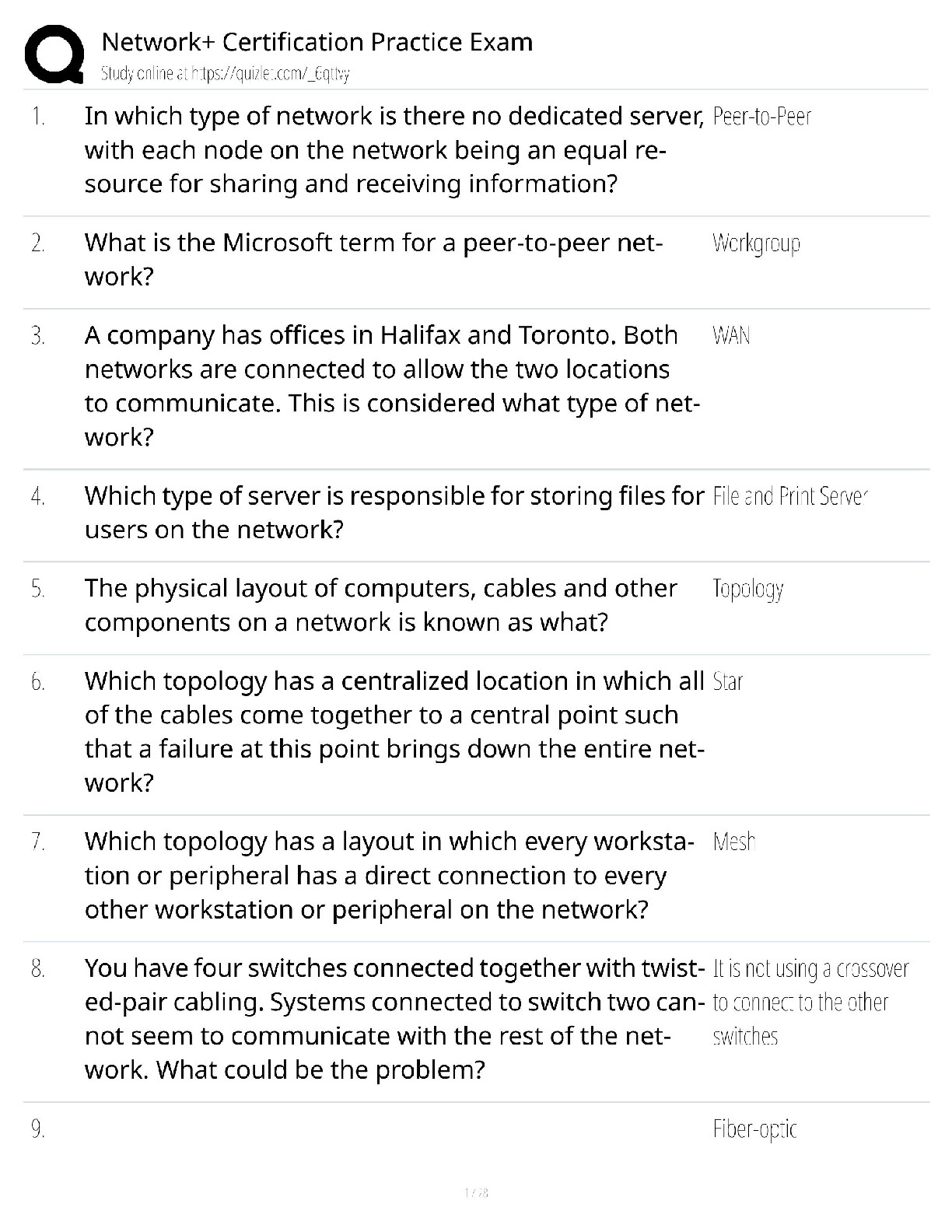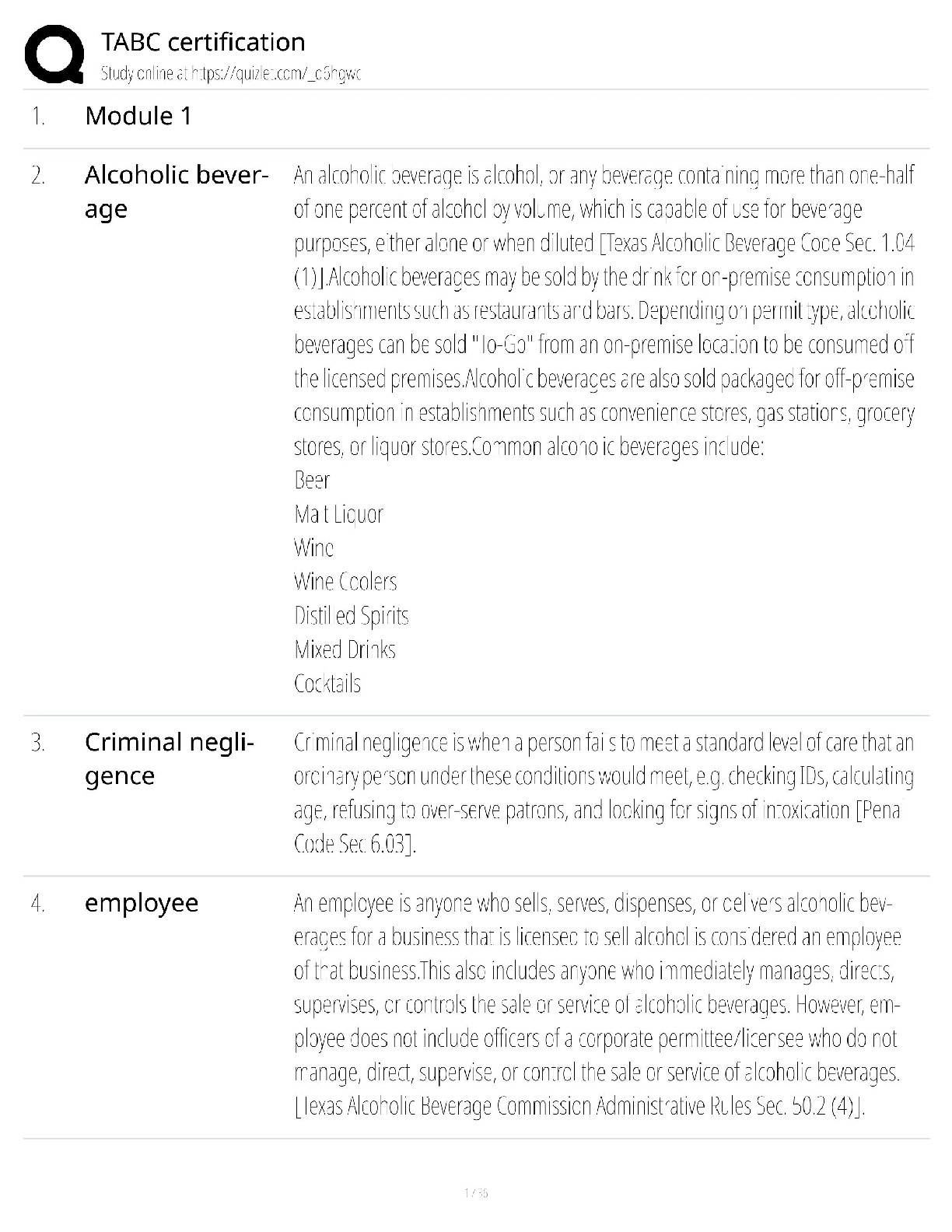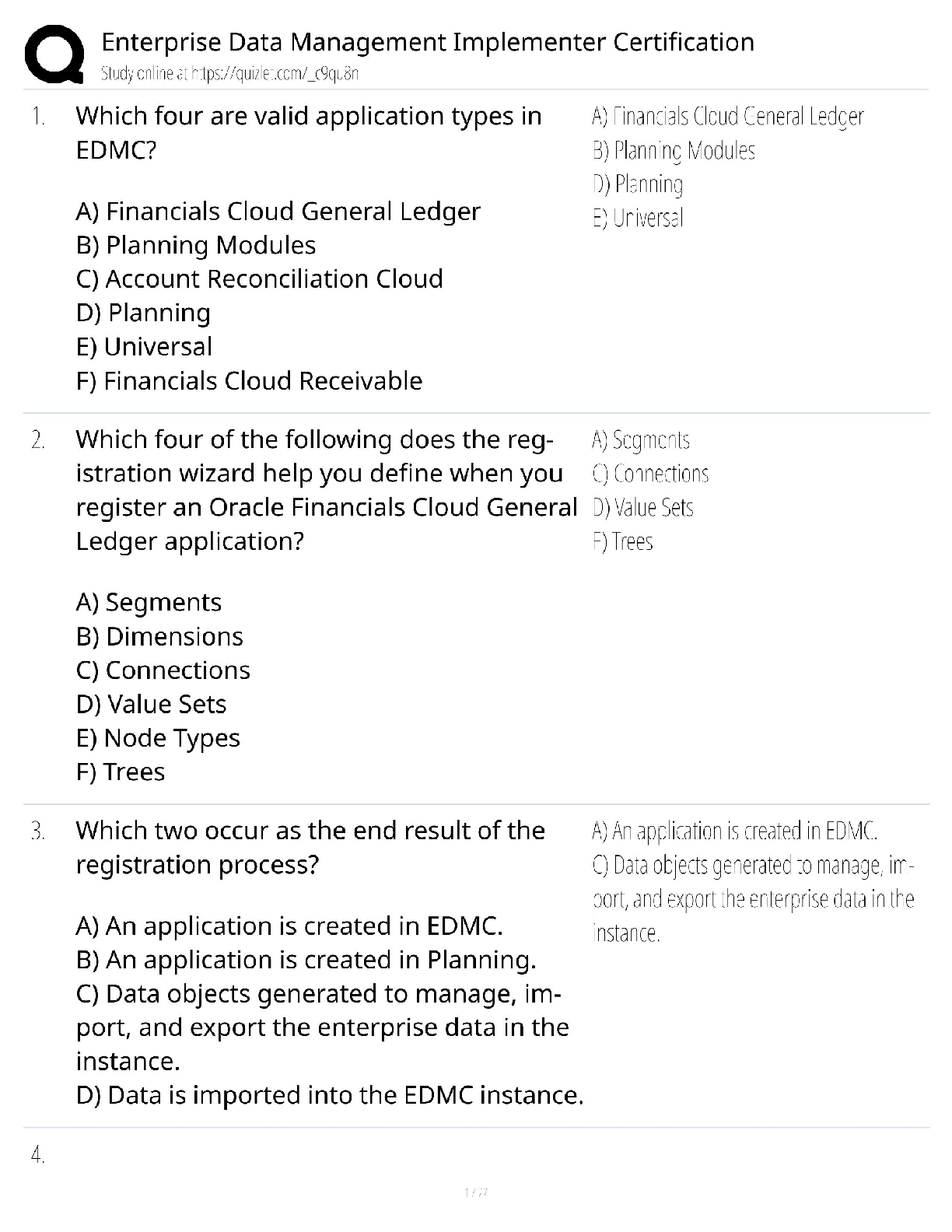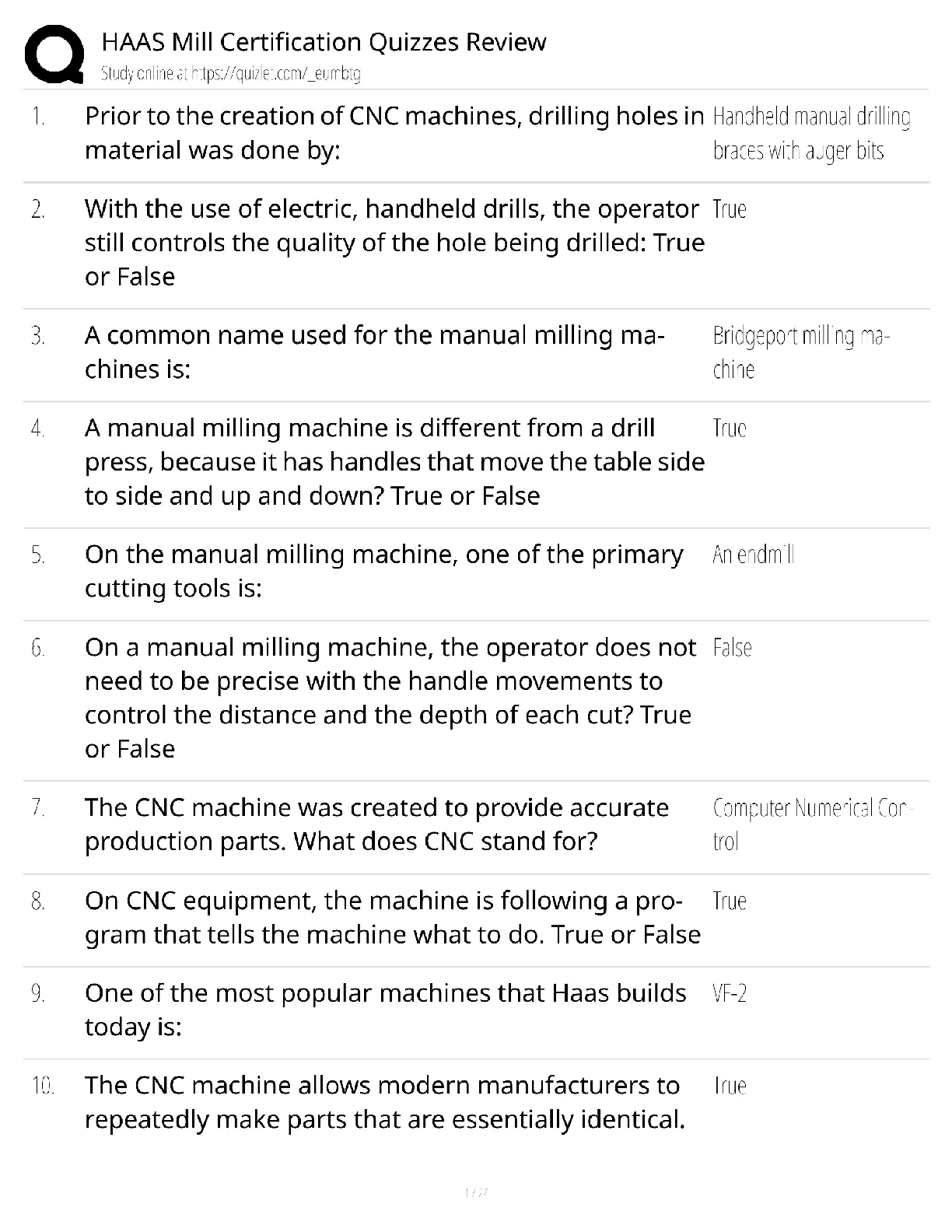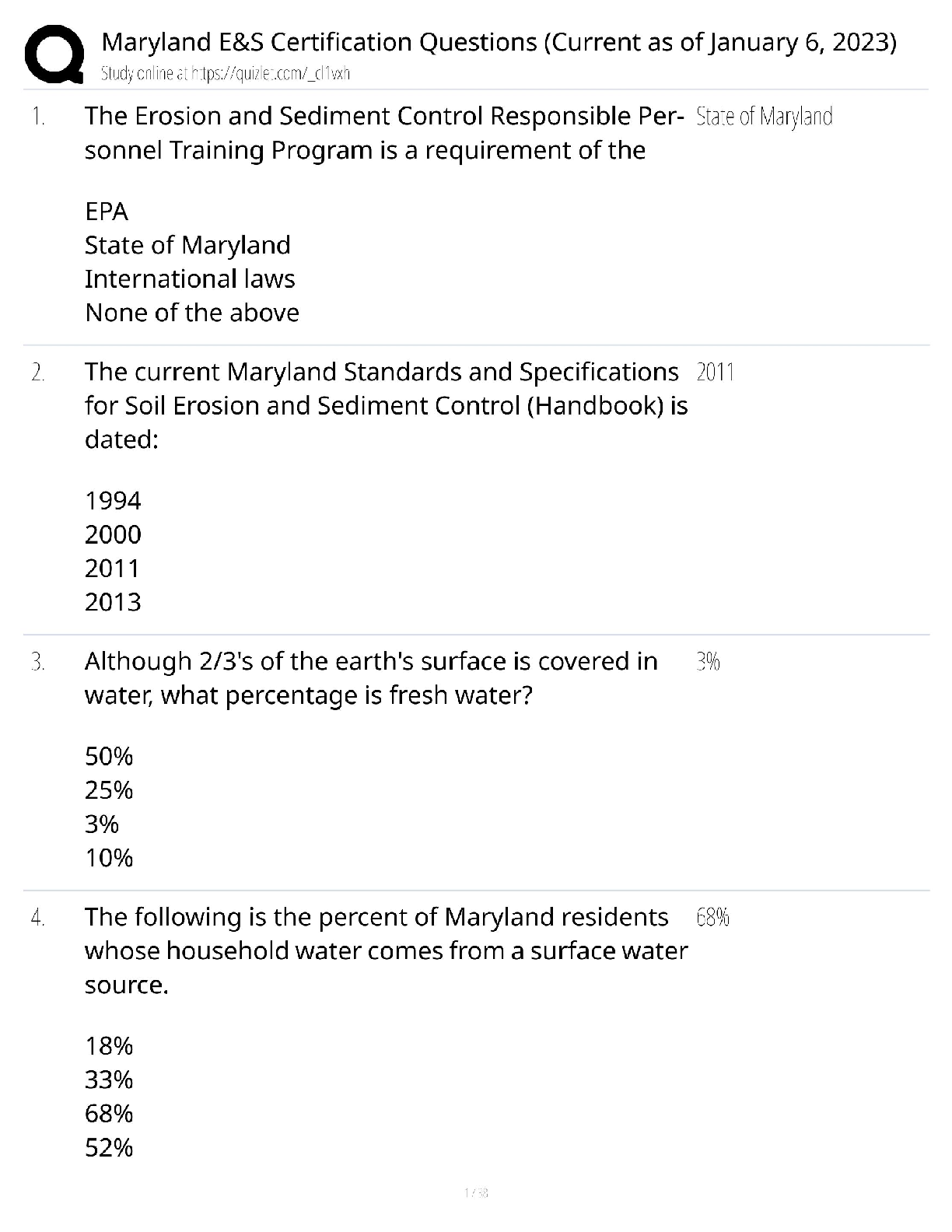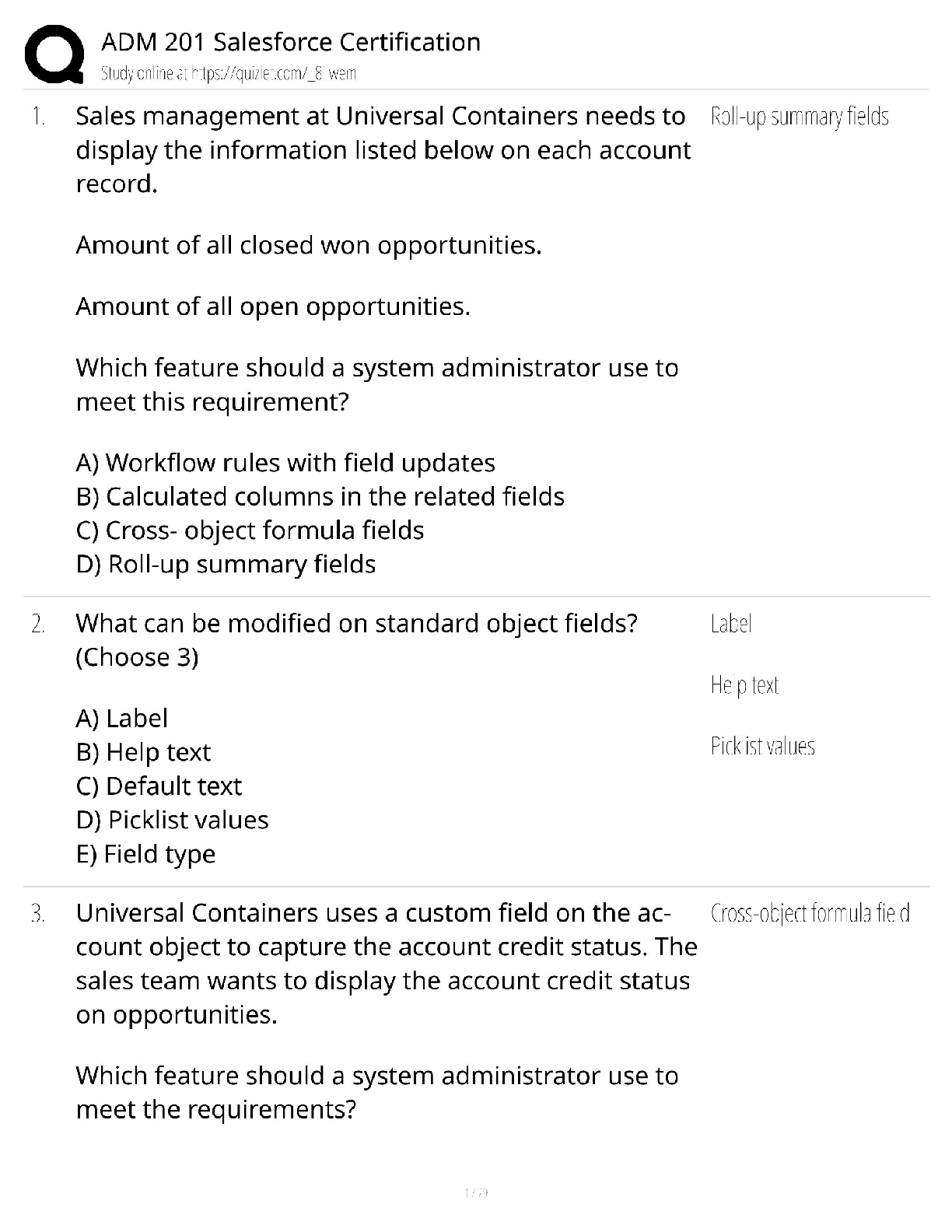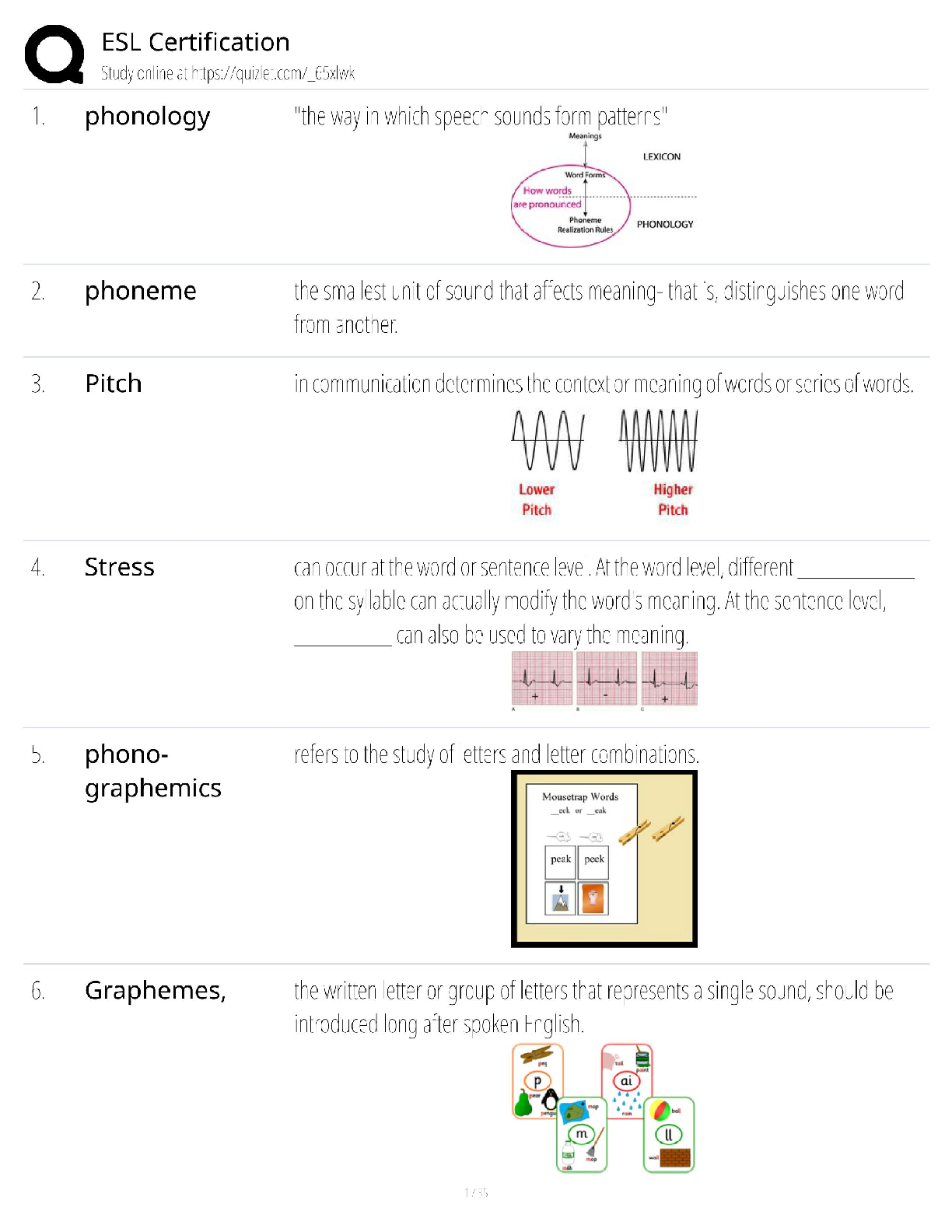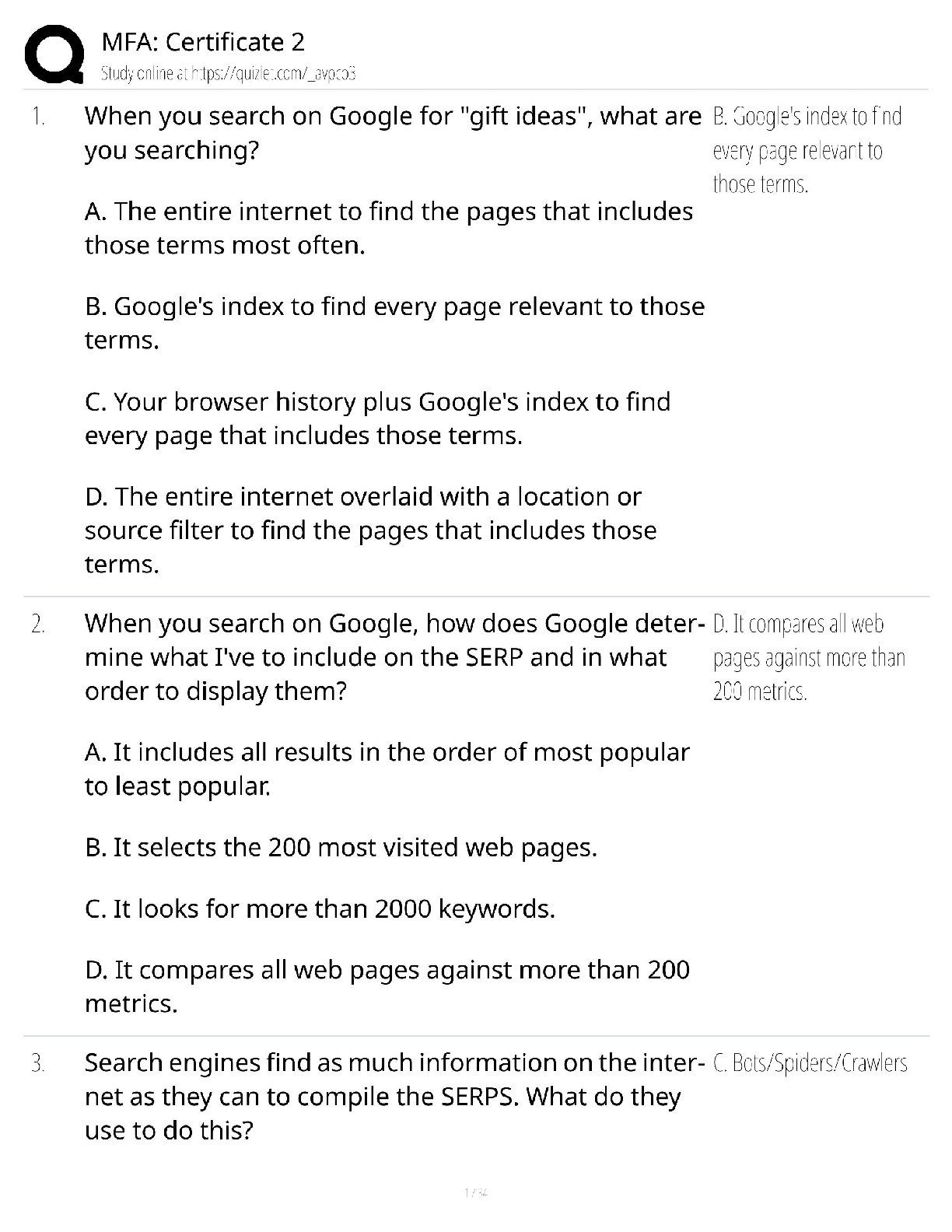*NURSING > QUESTIONS & ANSWERS > Hessi: Re-Take (MedSurge) tested exam questions with red color highlighted and correct answers (All)
Hessi: Re-Take (MedSurge) tested exam questions with red color highlighted and correct answers
Document Content and Description Below
Hessi: Re-Take (MedSurge) tested exam questions with red color highlighted and correct answers 1. A female client with possible acute renal failure (ARF) is admitted to the hospital and mannitol (O ... smitrol) is prescribed as a fluid challenge. Prior to carrying out this prescription, what intervention should the nurse implement? • No specific nursing action is required • Instruct the client to empty the bladder • Collect a clean catch urine specimen • Obtain vital signs and breath sounds 2. The nurse positions a male client for a lumbar puncture by placing him in the side-lying position with his knees flexed and pulled toward his trunk. What action should the nurse implement next? • Call another nurse to assist the healthcare provider • Provide a small pillow for the client to curl around • Instruct the client to perform a Valsalva maneuver • Support the client’s head bent forward to the chest 3. When teaching a client with osteoporosis to increase weight-bearing exercise, how should the nurse explain the purpose of this activity? • Strengthen leg muscles • Promote venous return • Increase bone strength • Restore range of motion 4. A male tells the clinic nurse that he is experiencing burning on urination, and assessment that he had sexual intercourse four days ago with a woman he casually met. Which action should the nurse implement? • Observe the perineal area for a chancroid-like lesion • Obtain a specimen of urethral drainage for culture • Identify all sexual partners in the last four days • Assess for perineal itching, erythemia, and excoriation 5. An older female client with long term type 2 diabetes mellitus (DM) is seen in the doctor routine health assessment. To determine if the client is experiencing any long-term complications of DM, which assessments should the nurse obtain? Select all that apply: • Visual acuity • Serum creatinine and blood urea nitrogen (BUN) • Signs of respiratory tract infection • Sensation in feet and legs • Skin condition of lower extremities 6. Which laboratory test result is most important for the nurse to report to the surgeon prior to a client’s scheduled abdominal surgery? • Potassium level of 4 mEq/liter • Blood glucose of 90 mg/dl • Serum creatinine of 5 mg/dl • Hemoglobin level of 13 grams 7. When caring for a client with nephrotic syndrome, which assessment is most important for the nurse to obtain? • Level of consciousness • Bowel sounds • Vital signs • Daily weight 8. A client who has a history of long-standing back pain treated with methadone (Dolophine), is admitted to the surgical unit following urological surgery. What modifications in the plan of care should the nurse make for this client’s pain management during the postoperative period? • Use minimal parenteral opioids for surgical pain, in addition to oral methadone • Maintain client’s methadone, and medicate surgical pain based on pain rating • Consult with surgeon about increasing methadone in lieu of parenteral opioids • Make no changes in standard pain management for this surgery and hold Methadone 9. The nurse applies an automatic external defibrillator (AED) to a client who collapsed in an exam room at a community clinic. What action should the nurse takes next? • Determine the defibrillator reading • Assess the client’s oxygen saturation • Bring a crash cart to the exam room • Measure the client’s blood pressure 10. Which change in lab values would indicate to the nurse that treatment for gout is successful? • Decreased serum uric acid • Decreased serum purine • Increased serum uric acid • Increased serum purine 11. A client is admitted with a sudden onset of right-sided he the nurse complete first? • Measure jugular vein distention • Measure oxygen saturation • Observe for peripheral edema • Auscultate the heart rate 12. The nurse reports that a client is at risk for a brain attack (stroke) finding? • Jugular vein distention • Palpable cervical lymph node • Carotid bruit • Nuchal rigidity 13. The drainage in the chest tube of a client with emphysema has changed from clear watery fluid to…..(missing information). What action would be best for the nurse to take? • Maintain the current IV antibiotic schedule • Schedule a portable chest x-ray per PRN protocol • “Milk” the tube to remove any clots (can be one of these 2 answers) • Obtain a specimen of the drainage for culture 14. A client who took a camping the clinic describing vague symptoms and diarrhea important for the nurse report to the healthcare provider (incomplete) • Weight loss • Intestinal cramping • Weakness and fatigue • Jaundice sclera 15. The nurse is assessing a group of older adults. What factor in a male client’s history puts him at greatest risk for developing colon cancer? • Is excessively exposed to sunlight • Eats a high-fat diet • Smokes cigars • Has intestinal polyps 16. While taking routine vital signs at 0400 AM, the nurse notes that a client who had a total knee replacement the previous day has a heart rate of 126 beats/minute. What action should the nurse take first? • Compare heart rate trends with blood pressure trends • Review the medical record for a history of cardiac disease • Check surgical drainage system and bandage for bleeding • Determine current pain level using a 10-point scale 17. When planning care for a client newly diagnosed with open angle glaucoma, the nurse identifies a priority nursing diagnosis of, “Visual sensory/perceptual alterations.” This diagnosis is based on which etiology? • Blurred distance vision • Photosensitivity • Decreased peripheral vision • Limited eye movement 18. A client who suffered an electrical injury on the left foot is admitted to the burn include in this client’s plan of care? (incomplete) • Assess lung sounds q4 hours • Perform passive range of motion • Evaluate level of consciousness • Continuous cardiac monitoring 19. The nurse is taking a client’s blood pressure sphygmomanometer cuff is inflated. What (incomplete) • Administer a prescribed PRN antianxiety • Assess the client’s recent serum calcium • Notify the healthcare provider of the • Prepare to implement seizure precautions 20. A client with pheocromocytoma reports the onset of a severe headache. The nurse observes that the client is very diaphoretic. Which assessment data should the nurse obtain next? • Body temperature • Capillary glucose • Blood pressure • Oxygen saturation 21. A client with eczema is using an over-the-counter (OTC) topical product with urea 10% OTC (Aqua Care Cream) to the affected skin areas. Which finding reflects the expected therapeutic response? • Decreased weeping of ulcerations in affected area • Healing with a return to normal skin appearance • Reduced pain in eczematous areas • Hydration of affected dry skin areas 22. During an annual health check, the clinic nurse updates an adult female’s health history. When discussing the woman’s history of lactose intolerance, the client reports that it has been years since she last consumed dairy products. What dietary suggestions should the nurse recommend to help ensure that the client receives an adequate intake of calcium? Select all that apply: • Increase intake of salmon, sardines, tofu, and leafy green vegetables • Sip a half-cup of mil during a mid-day meal at least every other day • Eat at least six servings of citrus fruits weekly • Include 2 to 3 servings of yellow and green squash weekly • Take a calcium supplement with vitamin D daily 23. A healthcare worker with no known exposure to tuberculosis has received a Mantoux tuberculosis skin test. The nurse’s assessment of the test after 72 hours indicates 5mm of erythema without induration. What is the best initial nursing action? • Review client’s history for possible exposure to TB • Instruct the client to return for a repeat test in 1 week • Refer client to a healthcare provider for isoniazid (INH) therapy • Document negative results in the client’s medical record 24. A male client in skeletal traction tells the nurse that he is frustrated because he needs help repositioning himself in bed. Which intervention should the nurse implement? • Inform the client that it is the nurse’s responsibility to reposition • Provide an overhead trapeze to the bed for the client to use • Place a draw sheet under the client to assist with repositioning • Administer an intravenous PRN anti-anxiety medication 25. In planning care for a client with pneumonia, which nursing problem should the nurse identify as the priority? • Impaired gas exchange related to the effects of alveolar-capillary membrane changes • Acute pain related to the effects of inflammation of the parietal pleura • Deficient fluid volume related to fever, infection, and increased metabolic rate • Disturbed sleep pattern related to pain, dyspnea, and hospitalization 26. A hospitalized client with chemotherapy-induced stomatitis complains of mouth pain. What is the best initial nursing action? • Encourage frequent mouth care • Administer a topical analgesic per PRN protocol • Cleanse the tongue and mouth with glycerin swabs • Obtain a soft diet for the client 27. A client returns from surgery following a hiatal hernia repair via Nissen fundoplication. Which position should the nurse implement for this client? • Right side-lying to promote stomach emptying • Prone to apply external pressure to the suture line • Left side-lying to reduce stress on the suture line • 30 degree semi-Fowler’s to drop the diaphragm 28. A client in the operating room received succinylcholine. The client is experiencing muscle rigidity and has an extremely high temperature. What action should the nurse implement? • Determine if prescribed antibiotics were administered preoperatively • Call the PACU nurse to prepare for prolonged ventilatory support • Hold a prescription for dantrolene (Dantrium) until fever is reduced • Prepare ice packs for placement in the client’s axillary area 29. A client who is receiving packed red blood cells develops nausea and vomiting. What action should the nurse take first? • Assess the client’s blood pressure • Administer an antiemetic • Stop the infusion of blood • Notify the healthcare provider 30. A client with type 2 diabetes mellitus (DM) is admitted to the hospital for uncontrolled DM. Insulin therapy is initiated with an initial dose of Humulin N insulin at 0800. At 1600, the client complains of diaphoresis, rapid heartbeat, and feeling shaky. What should the nurse do first? • Determine the client’s current glucose level • Give the client skim milk and crackers • Assess the client’s oxygen saturation level • Give the client one0half cup of fruit juice 31. An adult woman with Grave’s disease is admitted with severe dehydration is currently restless and refusing to eat. Which action is most important for the nurse to implement? • Keep room temperature cool • Determine the client’s food preferences • Maintain a patent intravenous site • Teach the client relaxation techniques 32. After suctioning the patient with an endotracheal tube, which assessment finding indicates to the nurse that the intervention was effective? • Increase in breath sounds • Absence of coarse crackles • Increase in respiratory rate • Absence of the fine crackles 33. The nurse admits a client who has a medical diagnosis of bacterial meningitis to the unit. Which intervention has the highest priority in providing care for this client? • Administer initial dose of broad-spectrum antibiotic • Instruct the client to force fluids hourly • Obtain results of culture and sensitivity of CSF • Assess the client for symptoms of hyponatremia 34. A client uses triamcinolone (Kenalog), a corticosteroid ointment, to manage pruritis caused by a chronic skin rash. The client calls the clinic nurse to report increased erythema with purulent exudate at the site. What action should the nurse implement? • Schedule an appointment for the client to see the healthcare provider • Advise the client to apply plastic wrap over the ointment to promote healing • Explain that the client needs to complete all prescribed doses of the medication • Instruct the client to continue the ointment until all erythema is relieved 35. The nurse observes an increased number of blood clots in the drainage tubing of a client with continuous bladder irrigation following a trans-urethral resection of the prostate (TURP). What is the best initial nursing action? • Provide additional oral fluid intake • Measure the client’s intake and output • Increase the flow of the bladder irrigation • Administer a PRN dose of an antispasmodic agent 36. During a paracentesis, two liters of fluid are removed from the abdomen of a client with ascites. A drainage bag is placed, and 50 ml of clear, straw-colored fluid drains within the first hour. What action should the nurse implement? • Palpate for abdominal distention • Clamp drainage tube for 5 minutes • Continue to monitor the fluid output • Send fluid to the lab for analysis 37. The nurse assesses the dressing of a client who has just returned from postanesthesia and finds that the dressing is wet with a moderate amount of bright red bloody drainage. What action should the nurse take? • Replace dressing with a new sterile dressing, and monitor the wound hourly until bleeding is stopped • Call surgery and request that the surgeon see the wound prior to leaving the hospital • Reinforce the dressing and document that a moderate amount of sanguineous drainage was on the dressing • Document that the dressing was saturated with serious drainage, and do not change the dressing 38. While the home health nurse is making a home visit, a client with a history of seizures demonstrates tonic-clonic seizure activity. What action should the nurse implement first? • Direct a family member to call emergency services • Ascertain the trigger event • Protect the client’s head with a pillow • Observe the postictal breathing pattern 39. Which nursing diagnosis should be selected for a client who is receiving thrombolytic infusions for treatment of an acute myocardial infarction? • Activity intolerance related to ischemia • Deficient knowledge related to a new medication regimen • Risk for injury related to effects of thrombolysis • Ineffective breathing pattern related to adverse drug effects 40. A client who weighs 176 pounds is admitted to the intensive care unit with a serum glucose level of 600 mg/dl and a serum acetone level of 50 mg/dl. Regular insulin at a rate of 0.1unit/kg/hour is prescribed. The pharmacy provides a solution of Regular insulin 100 units/100 ml of normal saline. The nurse should set the infusion pump to deliver how many ml/hour? (8 ml/hr) 41. A client whose history includes IV drug abuse is admitted to the intensive care unit (ICU) with Kaposi’s sarcoma associated with Acquired Immune Deficiency Syndrome (AIDS). Which intervention is most important for the nurse to include in the client’s plan of care? • Observe for adverse medication reactions • Assess for signs of AIDS dementia • Identify signs of opportunistic infections • Locate local HIV support groups 42. (Photo) The charge nurse observes a newly employed nurse gathering equipment to obtain a venous blood sample from a client’s implanted port. The nurse has obtained the equipment seen in the photo. What actions should the charge nurse take? (Select all that apply) • Guide the nurse in inserting the needle at a 45 degree angle • Remind the nurse to wear sterile gloves for this procedure • Instruct the nurse to obtain several red-topped tubes • Determine if the nurse has ever performed this skill • Assist in obtaining the correct needle to access the port 43. A client who weighs 175 pounds is receiving an IV bolus dose of heparin 80 units/kg. The heparin is available in a 2 ml vial, labeled 10,000 units/ml. How many ml should the nurse administer? (0.64 ml) 44. A client who had a biliopancreatic diversion procedure (BOP) 3 months ago is admitted with severe dehydration. Which assessment finding warrants immediate intervention by the nurse? A. Loose bowel movements B. Complaint of poor night vision C. Gastroccult positive emesis D. Strong foul smelling flatus 45. A client who is receiving packed red blood cells develops nausea and vomiting. What action should the nurse take first? A. Assess the client's blood pressure B. Administer an antiemetic C. Stop the infusion of blood D. Notify the healthcare provider 46. After a computer tomography (CT) scan with intravenous contrast medium, a client returns to the room complaining of shortness of breath and itching. Which intervention should the nurse implement? A. Send another nurse for an emergency tracheotomy set B. Call respiratory therapy to give a breathing treatment C. Review the client's complete list of allergies D. Prepare a dose of Epinephrine (Adrenalin) 47. The nurse is assessing a client who has returned from surgery following a thoracotomy. Which finding indicates the client is experiencing adequate gas exchange? A. The client's pulse rate is 82 and respiratory rate is 16 breaths per minute B. An oxygen saturation reading of 96 % is obtained using pulse oximetry C. The client demonstrates effective coughing and deep breathing exercises D. Current arterial blood gas results are pH 7.30, PaO2 75, and PaCO2 48 48. The nurse is reviewing blood pressure readings for a group of client's on a medical unit. Which client is at the highest risk for complications related to hypertension? A. Young adult Hispanic female who has a hemoglobin of 11 gm and drinks beer every day B. Middle-aged African-American male who has a serum creatinine level of 2.9 mg/dL C. Older Asian male who eats a diet consisiting of smoked, cured, and pickled foods. D. Post-menopausal Caucasian female who overeats and is 20% above ideal body weight [Show More]
Last updated: 3 years ago
Preview 1 out of 12 pages

Buy this document to get the full access instantly
Instant Download Access after purchase
Buy NowInstant download
We Accept:

Reviews( 0 )
$10.00
Can't find what you want? Try our AI powered Search
Document information
Connected school, study & course
About the document
Uploaded On
Dec 09, 2020
Number of pages
12
Written in
All
Additional information
This document has been written for:
Uploaded
Dec 09, 2020
Downloads
0
Views
146

 answers.png)












